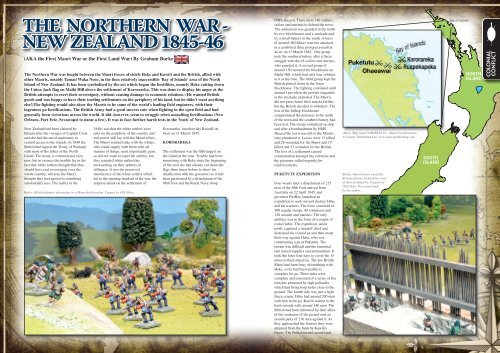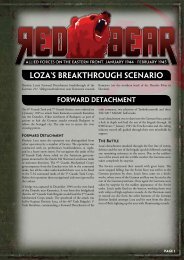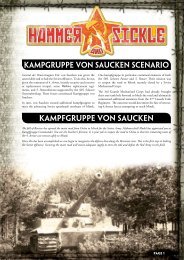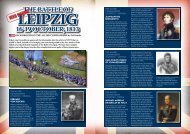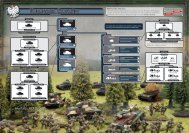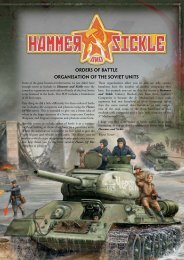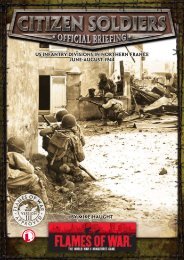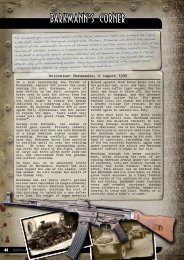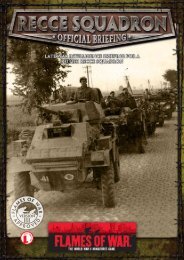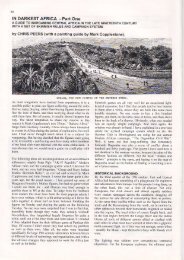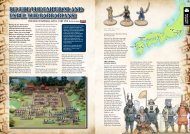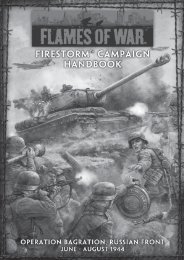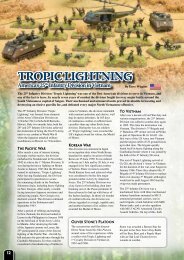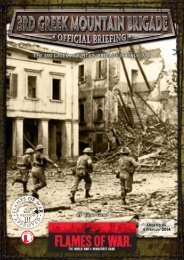Download a PDF version of this article here... - Flames of War
Download a PDF version of this article here... - Flames of War
Download a PDF version of this article here... - Flames of War
You also want an ePaper? Increase the reach of your titles
YUMPU automatically turns print PDFs into web optimized ePapers that Google loves.
THE NORTHERN WAR-NEWZEALAND1845-46(AKA the First Maori <strong>War</strong> or the First Land <strong>War</strong>) By Graham BurkeThe Northern <strong>War</strong> was fought between the Maori forces <strong>of</strong> chiefs Heke and Kawiti and the British, allied withother Maoris, notably Tamati Waka Nene, in the then relatively inaccessible 'Bay <strong>of</strong> Islands' area <strong>of</strong> the NorthIsland <strong>of</strong> New Zealand. It has been symbolised by the act which began the hostilities, namely Heke cutting downthe Union Jack flag on Maiki Hill above the settlement <strong>of</strong> Kororareka. This was done to display his anger at theBritish attempts to exert their sovereignty, without causing damage to economic relations. (He wanted Britishgoods and was happy to have their trading settlements on the periphery <strong>of</strong> his land, but he didn't want anythingelse!)The fighting would also show the Maoris to be some <strong>of</strong> the world’s leading field engineers, with theiringenious pa fortifications. The British Army had a good success rate when fighting in the open field and hadgenerally been victorious across the world. It did, however, seem to struggle when assaulting fortifications (NewOrleans, Fort Erie, Sevastopol to name a few). It was to face further harsh tests in the 'bush' <strong>of</strong> New Zealand.New Zealand had been claimed byBritain after the voyages <strong>of</strong> Captain Cookand she had the naval supremacy tocontrol access to the islands. In 1840 theBritish had signed the Treaty <strong>of</strong> Waitangiwith most <strong>of</strong> the tribes <strong>of</strong> the NorthIsland. The treaty is controversial evennow, but in essence the trouble lay in thefact that white settlers thought that theyshould have real sovereignty over thewhole country, w<strong>here</strong>as the Maorithought they had agreed to somethingsubstantially less. The reality in the1840s was that the white settlers wereonly on the periphery <strong>of</strong> the country andreal power still lay with the Maori tribes.The Maori wanted trade with the whites,who could supply with them with allmanner <strong>of</strong> things, most importantly guns,so did not want to expel the settlers, butthey resented white authoritiesencroaching on their sp<strong>here</strong>s <strong>of</strong>influence. It was the perceivedinterference <strong>of</strong> the white settlers whichled to the opening incident <strong>of</strong> the war, thesurprise attack on the settlement <strong>of</strong>Below: British infantry advancing on a Maori held postion. Figures by Old Glory.Kororareka (modern day Russell) at4a.m on 11 March 1845.KORORAREKAThe settlement was the fifth largest onthe island at the time. Trouble had beensimmering with Heke since the beginning<strong>of</strong> the year (he had already cut down theflag three times before to show hisdisaffection with the governor) so it hadbeen garrisoned by a detachment <strong>of</strong> the96th Foot and the Royal Navy sloopHMS Hazard. T<strong>here</strong> were 140 soldiers,sailors and marines to defend the town.The settlement was guarded in the northby two blockhouses and a stockade andby a small battery in the south. A force<strong>of</strong> around 450 Maori warriors attackedin a combined three pronged assault at4a.m. on 11 March 1845. One grouptook the southern battery after a fiercestruggle with the 45 sailors and marineswho guarded it. A second group <strong>of</strong>around 150 stormed the blockhouse onMaiki Hill, which had only four soldiersin it at the time. The third group kept theBritish pinned down in the lowerblockhouse. The fighting continued untilaround 1pm when the powder magazinein the stockade exploded. The Maorisdid not press home their attacks further,but the British decided to withdraw. Theloss <strong>of</strong> the hilltop blockhousecompromised the defences in the north<strong>of</strong> the town and the southern battery hadbeen lost. The troops embarked on shipand after a bombardment by HMSHazard the town was left to the Maoris,who plundered it. Losses were 13 killedand 28 wounded for the Maori and 19killed and 23 wounded for the British.The loss <strong>of</strong> a settlement causedconsternation amongst the colonists andthe governor called urgently forreinforcements.PUKETUTU EXPEDITIONFour weeks later a detachment <strong>of</strong> 215men <strong>of</strong> the 58th Foot arrived fromAustralia on 22 April 1845, andgovernor FitzRoy launched anexpedition to seek out and destroy Hekeand his warriors. The force consisted <strong>of</strong>300 regular troops, 40 volunteers and120 seamen and marines. The onlyartillery was in the form <strong>of</strong> a couple <strong>of</strong>rocket tubes. The expedition sailednorth, captured a 'neutral' chief anddestroyed his coastal pa and then madetheir way against Heke, who wasconstructing a pa at Puketutu. Theterrain was difficult and the torrentialrain ruined supplies and ammunition. Ittook the force four days to cover the 15miles to their objective. The pro BritishMaori had been busy skirmishing withHeke, so he had been unable tocomplete his pa. Three sides werecomplete and consisted <strong>of</strong> a series <strong>of</strong> firetrenches protected by high palisadeswhich had firing loop holes close to theground. The fourth side was just a lightfence screen. Heke had around 200 menwith him at the pa. Kawiti waited in thebush outside with around 140 men. TheBritish had been informed by their allies<strong>of</strong> the weakness <strong>of</strong> the pa and sent anassault party <strong>of</strong> 216 men against it. Asthey approached the fortress they wereattacked from the bush by Kawiti'sforces. The British turned around andAbove Map from FORTRESS 81 - Maori Fortifications© Osprey Publishing Ltd. www.ospreypublishing.comBelow: Maori forces await theBritish advance behind the cover<strong>of</strong> their fortified Pa. Figures byOld Glory. Pa scratch builtby the author.COLONIALCONFLICT
Above: lllustration by Adam Hook from FORTRESS 81 - Maori Fortifications © Osprey Publishing Ltd. www.ospreypublishing.comRuapekapeka was a stunning example <strong>of</strong> an early gunfighters’ pa,built by Hone Heke’s ally Kawiti in December 1845 and attacked bythe British for ten days in January 1846. Unlike most pre-colonialpa it was built in a clearing on a sloping hillside and was anirregular oblong with projecting angles to provide covering fire. Itwas surrounded by a single stout palisade - smaller than in earliertimes - into which loopholes had been cut at ground level; thedefenders lined a trench inside the stockade and fired out at groundlevel through the loopholes. The interior was full <strong>of</strong> whares -sleeping huts - which were protected by a variety <strong>of</strong> undergroundbunkers and bombpro<strong>of</strong> shelters. One section <strong>of</strong> the perimeter(foreground) had apparently not been finished when the Britisharrived and invested the pa. For ten days the British shelled the paintermittently, although damage was limited; a carronade belongingto the Maori and placed in the centre <strong>of</strong> the pa was destroyed by adirect hit, and one section <strong>of</strong> the palisade damaged. On 11 JanuaryBritish troops discovered the pa was apparently abandoned andoccupied it through the breach; a firefight then developed in thebush behind the pa, and it is thought that the Maori had abandonedthe pa in the hope <strong>of</strong> luring the British into an ambush in the bush.WARGAMING THENORTHERN WARThe small scale <strong>of</strong> the conflict lends itselfto rules such as Sharp Practice or theLegends <strong>of</strong> the Old West. 'Legends' hasthe advantage that you can swap betweenthe standard rules and the rules for'massed battles' in the Alamo supplement(which also has rules for fortifications)Whichever rules you use I think thefollowing considerations should be at theforefront <strong>of</strong> any amendments:The British had no real advantagein firepower. Both side used muskets.The British would tend to have abayonet and the Maoris would revertto hand weapons.The British should be superior in handto-handcombat, but the margin shouldnot be huge.The British will have a lot higherbreaking factor. They were moreferocious and prepared to takeheavy losses.The Maori should have the greaterinitiative and be able to take advantage <strong>of</strong>cover more than the British. On thedownside, they should break more easily.This is not to reflect that they were lessbrave, it is because they could not sustainheavy losses. During the conflict theysuffered around 170 casualties comparedto around 260 for the British and 40 proBritish Maori. But, as they had a warriorpool <strong>of</strong> only about 1,000, their losseswere proportionally greater.The pro British Maori were an importantfactor in the conflict. They should betreated as 'equal' allies rather thansubordinates. They <strong>of</strong>ten had theirown agenda and if possible should beplayed by someone apart from theBritish commander.For Sharp Practice I would suggestthat the British rankers are generallyone grade higher than the Maori warrior,but the Maori 'Big Men' have a higherinitiative level. Heke and Kawiti arevery much 'Cock o' the Walk' level 4,w<strong>here</strong>as I would limit the brave but notparticularly inspired British Officersto 'Fine Fallahs' level 2. I would ratepro British Maori exactly the same asthose who opposed the British. Theydid after all inflict the only substantivedefeat on Heke. I would also give theMaori the spotting bonuses and themovement bonuses <strong>of</strong> the Injuns in themain rulebook.For Legends I would suggest thefollowing pr<strong>of</strong>iles for the rank and fileBritish Soldier/SailorS F St G A W P4+ 4 3 3 1 1 4Soldier armed with musket and bayonet.Sailor armed with pistol and cutlass.Marines armed as soldiers. Break testafter 50% loss.Maori <strong>War</strong>riorS F St G A W P5+ 3 3 3 1 1 3Armed with musket and hand weapon.Break Test after 25% lossSpecial rule. If a Maori is within 'bush' or'forest' enemy models have to roll a'spotting check' to fire on him.For British NCOs I would add +1 to Gritand Pluck.CaptainS F St G A W P FA FT4+ 4 3 4 2 2 6 1 2Armed with a sword and pistol.Special rule: True Grit skill in the mainrule book.Maori war leaderS F St G A W P FA FT4+ 4 3 4 2 2 4 3 1Armed with a musket and a hand weaponSpecial rule: Is stealthy in bush or forestso enemy models have to pass a 'spottingcheck' to fire on him,You could always make up highercharacteristics for Heke and Kawiti.RUAPEKAPEKA EXPEDITIONIn late September 1845 FitzRoy wasreplaced as governor by George Grey.He rejected the terms that FitzRoy wasproposing and ordered a third Britishexpedition against Kawiti's new pa atRuapekapeka. The force was 1,300strong, including 800 regulars and a 400strong naval brigade. It also had someheavy artillery, including three 32pounders. Grey also asked the proBritish Maori to make attacks on theenemy. Despard commanded the Britishagain and, unsurprisingly proceeded withcaution. Strong stockades were built toprotect the batteries and pro BritishMaori were on hand to intercept anysorties by the pa's garrison. The Britishbombarded the pa day and night for twoweeks. This pa was even more advancedand the defenders lost few men toartillery fire. The heavier cannon didhowever make breaches in the pallisades.The Maori abandoned the pa, leavingonly a small rearguard, led by Kawitihimself, inside. The British and theirallies rushed into the position. T<strong>here</strong>arguard fired a volley and attempted todraw the British into the bush behind,w<strong>here</strong> they had set up an ambush. Theruse failed as the Maoris went backtowards the pa, fearing that Kawiti hadbeen killed. Both sides took cover andfired at each other for a few hours andthen the Maori withdrew. Britishcasualties amounted to 45 and theMaoris about 30. Grey claimed <strong>this</strong> wasa great victory and came to terms withHeke and Kawiti. Traditionally theNorthern <strong>War</strong> has been recorded as aBritish victory, though <strong>this</strong> has beenquestioned by revisionist historians.James Belich claims that Heke andKawiti came out on top. They did winsome notable victories and remained themain power in their own lands. They didlearn that they could not beat the Britishin the open and they also had a number<strong>of</strong> pro British tribes curbing their power(having been defeated by them). TheBritish had done enough for peace to berestored without losing face, but thelimits <strong>of</strong> their sovereignty had beenshown and the army had not learnt t<strong>here</strong>al lessons <strong>of</strong> overcoming the pafortifications, though they had gained themoral victory <strong>of</strong> proving hardier in opencombat. The result <strong>of</strong> <strong>this</strong> war was s<strong>of</strong>inely balanced that the experts cannotagree who really won, which makes itexcellent for wargamers, especially forthe colonial era w<strong>here</strong> conflicts tended tobe one sided or t<strong>here</strong> were suchdisparities in numbers that it is hard torecreate on the tabletop.


